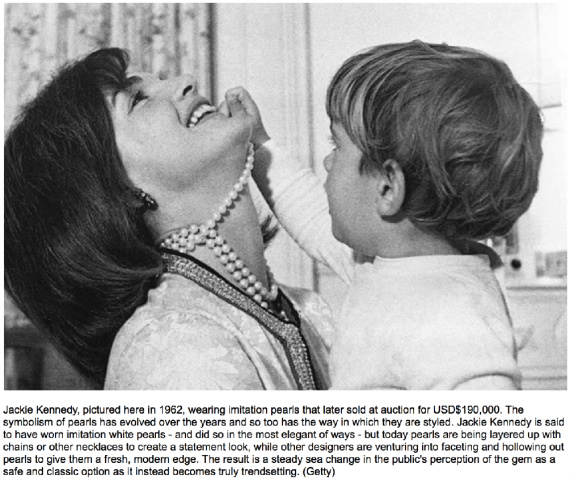A Pearl Imitation
Jackie Onassis Loved 'Em
 Triple Strand Pearl Imitation Necklace - A Firm Favorite of Jackie Kennedy
and the Kids!
Triple Strand Pearl Imitation Necklace - A Firm Favorite of Jackie Kennedy
and the Kids!It's an industry standard, pearl imitation or pearl substitutes that simulate Natural Pearls and Cultured Pearls require a verbal explanation (prior to sale) that the Pearls in question are indeed Imitation pearls or simulants of a natural pearl or cultured pearl. If there's a written presentation, the word 'pearl' should immediately be preceded by the word ‘imitation’ or ‘simulated’.
The pearl market is flooded with pearl imitations and Identifying Cultured Pearls from imitation pearl isn't always that easy. Pearl experts recommend using several tests to eliminate the pearl impostors. No one test is fool proof and certain tests are less effective with different types of imitation pearls.
Types of Imitation Pearls
- Solid glass beads
- Hollow glass beads containing wax - enter Grande dame Majorica Pearls
- Plastic beads
- Mother-of-pearl shell beads
Most Common Pearl Imitation Tests
 The famous tooth test!
The famous tooth test!- Tooth Test: Gently rub the pearl lightly across the enamel of your teeth.
Genuine Cultured and Natural Pearls will feel gritty or rough. An Imitation pearl will feel smooth against your teeth. - Magnification Test: inspect the surface of the pearl with a Jewelers Loupe or magnifying glass. If you are not sure how to use a Jewelers loupe, find out Here....
When you purchase a loupe make sure to get a loupe 10x that is "fully corrected" meaning that you can look through the whole lens and get a clear and undistorted image, not just through the centre.
Genuine pearls will appear fine-grained. An imitation pearl appears grainy. - The Drill Hole Test: Examine the drill holes of the pearl with a loupe. The edges of the natural pearl or cultured pearls will appear smooth and uniform. Imitation Pearls are usually rough and ragged around the edges of the drill hole.
- Heaviness Test: Drop the pearls into your hand. (no more than five inches). Genuine cultured pearls or natural pearls feel heavier in the hand than an fake pearl. Majorica pearls are the exception.
Unless the Imitation pearls are solid glass beads, the impostors will usually feel light.
You can tell a lot about the quality of a strand of pearls from the weight of the pearls. You can tell quite a bit from the weight of all jewelry really with the exception of Amber Jewelry which is much lighter than its counterfeit cousins. - Flaw Test: Examine the pearls for any flaws and blemishes. Now here is the twist-in-the- tail. Genuine pearls will NOT be flawless.
Natural pearls will not be perfect in shape and most likely will have slight blemishes or even a pimple or two. Unless it's a really good pearl cheat, an imitation will appear flawless.
- Price Test: Compare prices with similar types of pearls on the market. Genuine pearls will be priced accordingly, and should be higher in price than imitation pearls. Imitation Pearls should be lower priced or discounted. A pearl cheat will price the impostor pearls close to the price of genuine pearls to deceive unwary buyers; pearl cheats mark-up the price of the pearl imitation to align with genuine pearl prices and...you guessed it... enjoy the outrageous profit from the fraud.
Reference:
http://en.wikipedia.org/wiki/Pearl
Photo Credit:
http://www.professionaljeweller.com/pics-14141-trends-in-pics-pearl-jewellery-then-and-now/1
Return to the top of Pearl Imitation
Return to Cultured Pearls
Return to Antique Jewelry Investor
